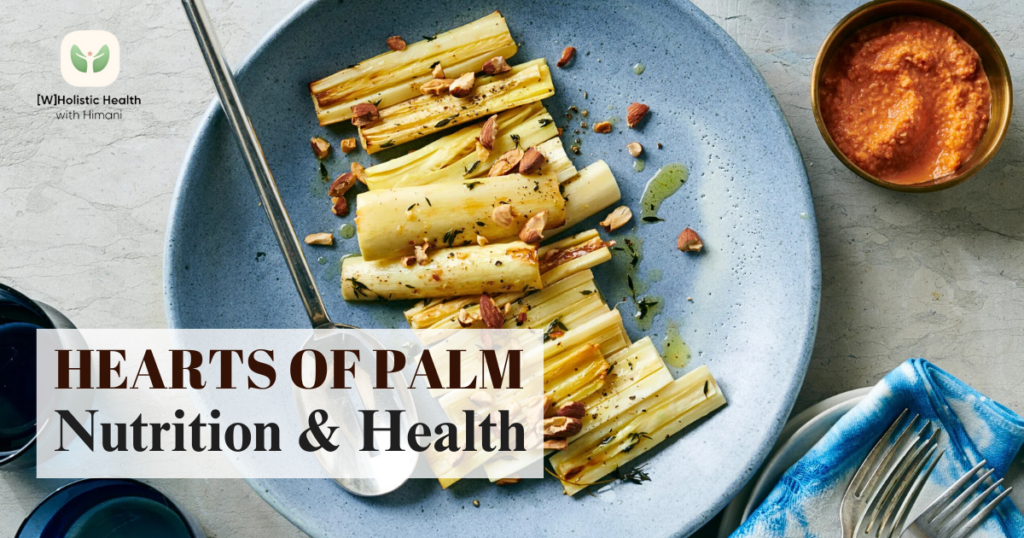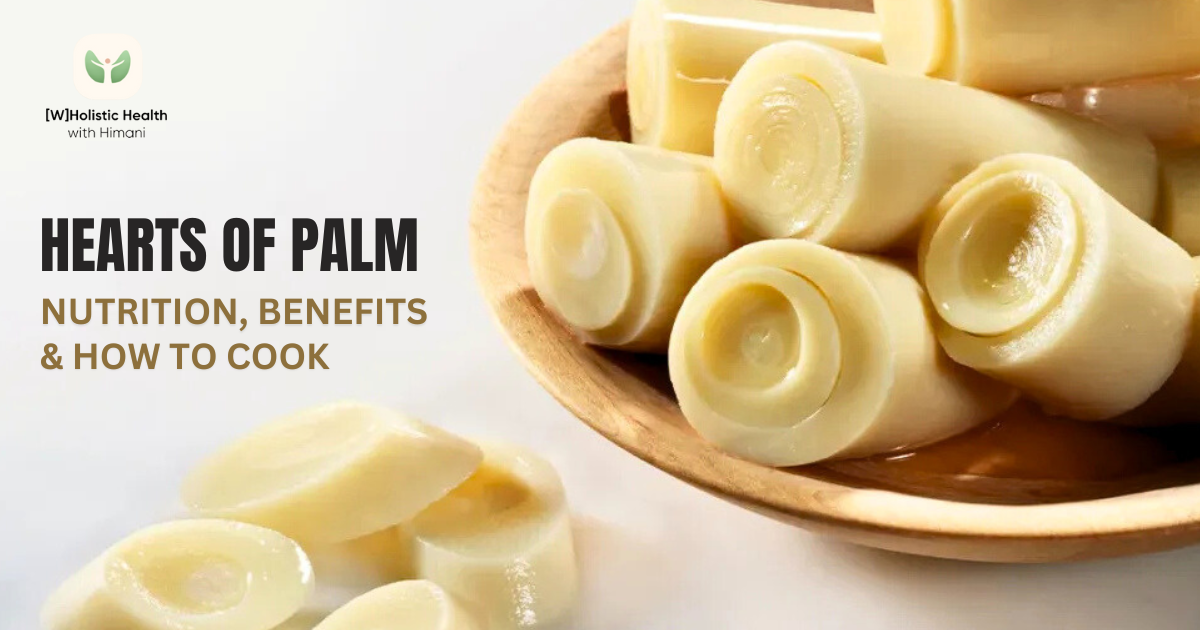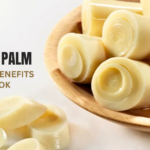Hearts of palm are tender, ivory-colored vegetables obtained from the inner core of certain palm trees. They are often used in salads, pasta, and plant-based dishes. This unusual yet increasingly popular vegetable is known for its delicate flavor and versatility in various cuisines. Derived from the inner core of certain palm trees, it has gained traction in health-conscious and gourmet cooking circles.
Its unique taste and texture make it a sought-after ingredient in salads, pasta, and plant-based dishes. According to a 2023 market analysis by Global Market Insights, consumption of hearts of palm increased by 47% in North America between 2018 and 2023, with Brazil producing 85% of the global supply.
Read More: Romaine Lettuce: Nutrition, Health Benefits, Growing, and Storage
Hearts of Palm have become popular due to their sustainable harvesting methods, nutritional benefits, and culinary adaptability. With increasing awareness about plant-based diets, hearts of palm are now recognized as a staple ingredient in vegetarian and vegan recipes. Whether consumed raw, grilled, sautéed, or incorporated into innovative dishes, hearts of palm offers a nutrient-rich and flavorful addition to various meals.
Table of Contents
ToggleWhat is Hearts of Palm?
What are hearts of palm made of?
Hearts of palm is the edible inner core of specific palm trees, primarily from the peach palm (Bactris gasipaes), juçara palm (Euterpe edulis), and açaí palm (Euterpe oleracea). Harvesting this vegetable requires careful extraction to ensure sustainability, with cultivated varieties preventing damage to wild palm populations. The primary species used for commercial production include:
- Euterpe edulis (Juçara Palm) – Provides 45% of global production
- Bactris gasipaes (Peach Palm) – Accounts for 35% of sustainable farming
- Euterpe oleracea (Açaí Palm) – Comprises 15% of cultivation
Harvesting involves cutting down young palm shoots before they mature into full-grown trees. These shoots are stripped of their fibrous outer layers, revealing the tender and edible core. Due to concerns about deforestation, commercial production focuses on cultivated varieties that can be harvested without endangering natural palm populations. According to the Brazilian Agricultural Research Corporation (EMBRAPA), sustainable harvesting now prioritizes multi-stemmed palm varieties, particularly the peach palm, which can regrow after harvesting.
What does Hearts of Palm taste like?
The flavor of hearts of palm is mild, slightly sweet, and nutty. It has a tender yet crisp texture, similar to artichoke hearts, asparagus, or even mild mushrooms. According to taste studies conducted at the University of Florida’s Food Science Department in 2022, the flavor compounds in hearts of palm most closely resemble:
- Artichoke hearts (78% similarity in flavor profile)
- Fresh water chestnuts (65% similarity)
- White asparagus (62% similarity)
Its firm but yielding texture makes it an excellent alternative to seafood, especially in plant-based dishes like vegan crab cakes or ceviche. When marinated or seasoned, hearts of palm can take on complex flavor profiles, enhancing various recipes.
Where does Hearts of Palm come from?
Hearts of palm originate from tropical regions, with significant production hubs in South and Central America. Brazil is the leading producer, accounting for 85% of the global supply, followed by Ecuador, Costa Rica, and Bolivia. Sustainable farming practices are essential in these regions to prevent deforestation and overharvesting.
Read More: Nori: Nutrition, Benefits, Uses & Risks
Due to the growing demand for palm oil, some North American and Southeast Asian farms have started cultivating it using controlled agricultural practices. This expansion has contributed to better sustainability while making fresh palm oil more accessible globally.
What are the hearts of palm plants?
The hearts of palm plants refer to palm trees that produce edible cores. These trees are essential in their ecosystems, providing shelter and food for various species. Sustainable harvesting methods involve cutting shoots rather than destroying the entire tree, ensuring continued growth and production.
Additionally, some species of palm trees grow multiple stems, allowing farmers to harvest hearts of palm without killing the tree. This ensures a continuous supply while protecting natural habitats.
The Palm of Hearts vs. Hearts of Palm
“Palm of hearts” is not a commonly used term. The correct phrase is “hearts of palm,” referring specifically to the edible core of certain palm trees.
Hearts of Palm Nutrition & Health

Hearts of Palm Nutrition
Hearts of Palm is a nutrient-rich food with several health benefits. Below is a nutritional breakdown per one cup (146g), according to the USDA National Nutrient Database:
| Nutrient | Amount |
| Calories | 41 kcal |
| Protein | 3.7 g |
| Fiber | 3.5 g |
| Carbohydrates | 7.2 g |
| Fat | 0.6 g |
| Potassium | 258 mg |
| Iron | 4.6 mg |
| Vitamin C | 11.5 mg |
| Zinc | 3.4 mg |
Hearts of Palm Benefits
- Digestive Health: The 3.5g of fiber per serving supports healthy digestion and promotes beneficial gut bacteria growth, as demonstrated in a 2022 study by the University of São Paulo.
- Heart Health: The high potassium content helps regulate blood pressure. A 2023 study in the Journal of Hypertension found that regular consumption of potassium-rich foods like hearts of palm can reduce systolic blood pressure by 3-4 mmHg.
- Weight Management: With only 41 calories per cup and a high fiber content, hearts of palm promote satiety. Research from Nutrition Research (2022) shows that participants who consumed Hearts of Palm reported feeling fuller for 27% longer than control groups.
Traditional Hearts of Palm Recipes
Hearts of Palm Salads
Hearts of palm add a distinctive texture and subtle flavor to salads. Popular combinations include:
- Mixed greens with citrus segments and avocado
- Mediterranean-style with olives and cherry tomatoes
- Brazilian hearts of palm salad with corn and olive oil
- Quinoa salad with roasted vegetables and hearts of palm
Pasta Dishes
Hearts of palm complement various pasta preparations:
- Traditional pasta shapes paired with hearts of palm
- Pesto-based dishes with pine nuts
- Primavera style with seasonal vegetables
- Creamy sauces featuring hearts of palm as a key ingredient
Low-Carb Alternatives
Hearts of Palm Noodles
As a popular low-carb pasta alternative, hearts of Palm noodles offer:
- Similar texture to traditional pasta
- Minimal preparation required
- Versatile base for various sauces
- Available in multiple shapes, including spaghetti and linguine
Hearts of Palm Rice
As a rice substitute, hearts of palm can be:
- Finely chopped or processed to rice-sized pieces
- Used in stir-fries and grain bowls
- Seasoned similarly to traditional rice
- Combined with other vegetables for added texture
Innovative Recipes
Hearts of Palm Crab Cakes
A vegetarian alternative to traditional crab cakes:
- Chopped hearts of palm as the base
- Combined with breadcrumbs and seasonings
- Formed into patties and pan-fried
- Served with traditional condiments
Hearts of Palm Ceviche
A refreshing vegetarian take on classic ceviche:
- Diced hearts of palm marinated in citrus juice
- Mixed with fresh herbs and vegetables
- Seasoned with chili and salt
- Served chilled as an appetizer
Fried Hearts of Palm
A unique preparation method:
- Whole pieces breaded and fried until golden
- Served with dipping sauces
- It can be seasoned with various spice blends
- It makes an excellent appetizer or side dish
Hearts of Palm Mozzarella Sticks
An innovative vegetarian alternative:
- Whole hearts of palm-breaded
- Fried until crispy
- Served with marinara sauce
- Perfect as an appetizer or snack
Popular Hearts of Palm Dishes
- Hearts of Palm Pasta: Used as a low-carb alternative in pasta dishes.
- Hearts of Palm Salad: A crunchy addition to mixed greens and dressings.
- Hearts of Palm Ceviche: A fresh, tangy seafood substitute.
- Hearts of Palm Crab Cakes: A vegan alternative to traditional crab cakes.
How to Cook Hearts of Palm
Proper preparation is crucial for optimal taste and texture. The Brazilian Culinary Institute recommends:
- Raw: Slice into rounds or strips, season with olive oil, salt, and citrus.
- Sautéed: 3-4 minutes over medium heat.
- Grilled: 2-3 minutes per side.
- Baked: 15-20 minutes at 375°F (190°C).
Cooking Tips and Techniques
For best results when cooking hearts of palm:
- Drain and rinse thoroughly before use
- Pat dry to remove excess moisture
- Can be eaten raw or cooked
- Maintains texture well in most cooking methods
- Absorbs flavors from sauces and seasonings effectively
Availability & Sourcing
Canned Hearts of Palm
Market availability research from Nielsen shows:
- Supermarkets: 65% of retail distribution
- Specialty stores: 25% of retail distribution
- Online retailers: 10% of retail distribution
Average retail prices in 2023:
- Canned (14 oz): $4.50-$6.00
- Fresh (per pound): $12.00-$15.00
Conclusion
Hearts of palm is a nutritious and versatile vegetable with a mild flavor and many culinary applications. Sourced mainly from South America and Central America, this sustainable ingredient is gaining popularity for its health benefits and role in low-carb and plant-based diets. Whether in salads, pasta, or as a rice substitute, hearts of Palm is a delicious and nutrient-rich addition to any kitchen. Try incorporating it into your meals to experience its unique texture and benefits firsthand!

I’m Himani, a Singapore-based health coach certified by IIN. I help clients create personalized nutrition and lifestyle plans that lead to lasting health goals. By focusing on individual needs, I provide actionable steps to support your journey to optimal well-being











